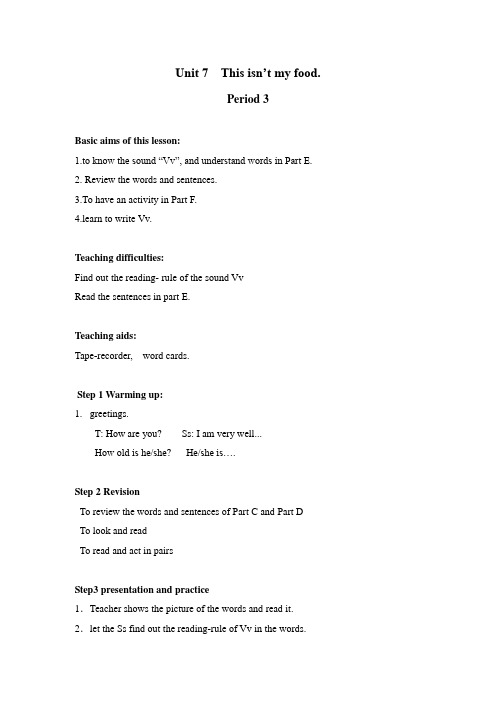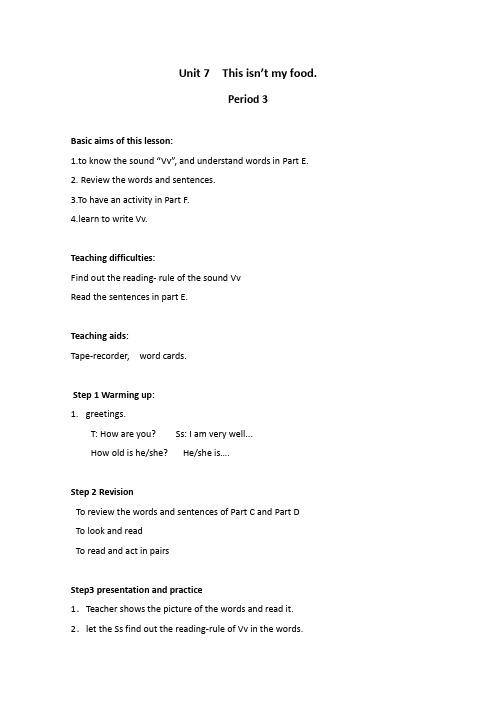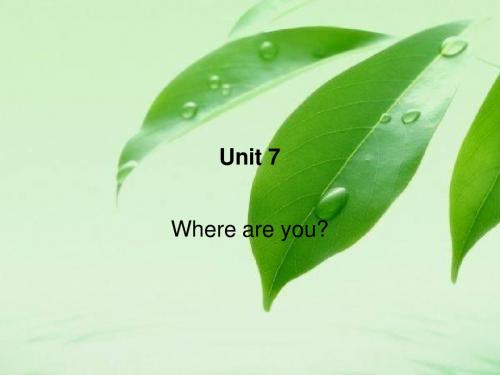鲁湘版小学英语三年级下册3B Unit 7 Where are you 第3课时 教案(教学设计)
- 格式:wps
- 大小:93.54 KB
- 文档页数:3

Unit 7 This isn’t my food.Period 3Basic aims of this lesson:1.to know the sound “Vv”, and understand words in Part E.2. Review the words and sentences.3.To have an activity in Part F.4.learn to write Vv.Teaching difficulties:Find out the reading- rule of the sound VvRead the sentences in part E.Teaching aids:Tape-recorder, word cards.Step 1 Warming up:1. greetings.T: How are you? Ss: I am very well...How old is he/she? He/she is….Step 2 RevisionTo review the words and sentences of Part C and Part D To look and readTo read and act in pairsStep3 presentation and practice1.Teacher shows the picture of the words and read it. 2.let the Ss find out the reading-rule of Vv in the words.3.Write out other words in part E with “Vv”. 4.Let Ss try to read.5. Listen to the tape of Part E.6. read the words and sentences7.Sum up the reading rule of "Vv"in words 8.Write “Vv” in the book.Step 4. Consolidation1. Part F: Let′s have fun2. Listen to the tape( A,B, C, D) then read after it.3. Exercises book ”Handwriting on the blackboard:Unit 7 This isn’t my food.Tt telephone television toy train。

Unit 7 Where are you?Period 1【学习目标】1.用所学词语和句型讨论打电话这个话题。
2.会用所学句型进行问答对话,掌握生词。
【学习重难点】1.词汇:park school call hello2.句型:(1)Let’s call Wang Li.(2)What’s his number?(3)This is Zhou Lin. May I speak to Wang Li, please?(4)-Where are you?-I am in the park.【学习过程】1.复习回顾(1)Let’s draw a…!(2)Pass me the crayon, please.(3)This one? No, the green one!(4)巩固和复习上节所学内容。
2.设问导读(1)看图学单词:(2)学习句子或对话:①Let’s call Wang Li.②What’s his number?③This is Zhou Lin. May I speak to Wang Li, please?④-Where are you?-I am in the park.根据课本,反复操练。
3.巩固练习单词碰碰车。
()公园A.park B.home()学校A.park B.school()打(电话)A.call B.drawPeriod 2【学习目标】1.用所学词语和句型讨论打电话这个话题。
2.会用所学句型进行问答对话,掌握生词。
【学习重难点】1.词汇:park school call hello2.句型:(1)This is… May I speak to…?(2)Speaking!(3)Where are you? I am at home.【学习过程】1.复习回顾(1)Let’s call Wang Li.(2)What’s his number?(3)This is Zhou Lin. May I speak to Wang Li, please?(4)Where are you? I am in the park.(5)巩固和复习上节所学内容。

Unit 7 This isn’t my food.Period 3Basic aims of this lesson:1.to know the sound “Vv”, and understand words in Part E.2. Review the words and sentences.3.To have an activity in Part F.4.learn to write Vv.Teaching difficulties:Find out the reading- rule of the sound VvRead the sentences in part E.Teaching aids:Tape-recorder, word cards.Step 1 Warming up:1. greetings.T: How are you? Ss: I am very well...How old is he/she? He/she is….Step 2 RevisionTo review the words and sentences of Part C and Part D To look and readTo read and act in pairsStep3 presentation and practice1.Teacher shows the picture of the words and read it. 2.let the Ss find out the reading-rule of Vv in the words.3.Write out other words in part E with “Vv”. 4.Let Ss try to read.5. Listen to the tape of Part E.6. read the words and sentences7.Sum up the reading rule of "Vv"in words 8.Write “Vv” in the book.Step 4. Consolidation1. Part F: Let′s have fun2. Listen to the tape( A,B, C, D) then read after it.3. Exercises book ”Handwriting on the blackboard:Unit 7 This isn’t my food.Tt telephone television toy train。



Unit7 单元总览
一、教学目标
二.单元分析
1. 学习链接
(1) 词汇
lemon, orange在三年级上册第四单元E部分字母环节中出现,但不要求掌握。
(2) 句型
①句型“Is it a cat?”“Ye s, it is. / No, it isn’t.”,已在三年级上册第七单元中学习过。
②句型“I like…”已在三年级上册第十一单元中作为重点句型让学生掌握。
2. 话题解读
本单元话题为水果(Fruits),与水果类单词结合的是询问水果名称的句型。
在教学中,教师可利用水果图片、实物或简笔画来辅助教学,还可以利用猜物游戏、快速反应、创设情景让学生运用本单元词汇和句型谈论水果。
3. 难点分析
(1) orange这个单词既可作水果名称,又可作颜色单词。
(2) 可数名词单数前用a或an。
本难点已在三年级上册第九单元出现,教师只需让学生进一步感知这一语音或语法现象。
三、课时安排
四、本单元知识拓展
与水果有关的趣味俚语
Apple
1. the apple of one’s eye 掌上明珠
2. the Big Apple 纽约城
Banana
1. go bananas疯狂,发疯
2. top banana重要人物
Lemon
lemon废物,不值钱的东西
Peach桃子
peach of a...受人喜欢的人或物。
鲁湘版三年级下册Unit 3 I like running.~Section B 69Do you like __________?watching TV Yes, ______.No, _______.I doI don’tDo you like _______?drawing Yes, ______.No, _______.I doI don’tDo you like _______?reading Yes, ______.No, _______.I do I don’tLead-inListen and chant—What do es she like to do?—She like s to sing.sing—What do es he like to do?—He like s to run.PresentationLook, listen and tryWhat do you like to do?What does she liketo do?I like to read.She like s to sing.小组合作,一起来练习Look,listen and try 部分的对话,随后表演出来吧!Role playPracticePracticeLook and say —What does he/she like to do?—He/She likes to …Write and talk Practice What do es he like to do?He like s to …Work with your partner. Write down what they like to do. Take turns to ask each other. What does he/she like to do?Summary如何询问某人喜欢做什么并做回答?—What do es he/she like to do?—He/She like s to …Homework1. 学唱本课Listen and chant部分的歌曲,并唱给你的父母听。
鲁湘版小学英语三年级下册3B 教案(教学设计)Unit 7 Where are you? 第3课时教学目标学生能用所学打电话的词语和句子谈论所在的处所等。
学生能听懂课文对话,并能打电话就对方所在处所等进行简单交流。
培养学生与其他同学合作,共同完成学习任务的团队精神。
教学重难点句型: This is Zhou Lin.May I speak to ..., please?Speaking.Where are you?I'm ...What's your number?教学活动教师让学生两人一组,讨论打电话的主要内容,然后互相进行一次真实的打电话演示。
课前准备教师课前需要准备录音机、磁带、教学挂图、电话或手机等。
教学过程任务6的教学:教师向学生展示课文Look, listen and try的教学挂图,让学生仔细看图中有哪些人物,分别说了什么话。
教师根据课文内容提几个问题,比如“请同学们注意听课文中出现了几个人名?”然后放课文录音。
教师将学生分成两人一组,根据课文内容进行对话表演。
任务7的教学:教师将学生分成两人一组,在课文的Write,ti ck and talk中写下自己的电话号码,并在自己所在的处所后画√号。
小组双方轮流问对方一个问题:What's yournumber? 并在课文右栏横线上写下搭档的电话号码。
然后双方通一次电话(通话内容应包括图片下面的主要句型),并在右栏搭档所在的处所后画√号。
任务8的教学:教师放Listen and chant的录音,先让学生听小诗Where are you? 然后,让他们跟着学读。
教师可预先准备两部电话或手机,让两个学生手拿电话或手机站在讲台两边;随着录音的播放和学生朗读,这两个学生做着打电话的样子(口中可以跟随读小诗)。
任务9的教学:教师将学生分成3人一组,就课文中学过的内容进行对话和表演。
对话应包括下面的主要句型:What's his/her number?May I speak to ..., please? Speaking.Where are you?I'm at home/in the park/at school.学生在小组进行对话练习的过程中,教师要在全班巡视、指导,发现对话表演较好的小组,可以让他们到讲台上向全班同学表演对话。
鲁湘版小学英语三年级下册3B 教案(教学设计)
Unit 7 Where are you? 第3课时
教学目标
学生能用所学打电话的词语和句子谈论所在的处所等。
学生能听懂课文对话,并能打电话就对方所在处所等进行简单交流。
培养学生与其他同学合作,共同完成学习任务的团队精神。
教学重难点
句型: This is Zhou Lin.
May I speak to ..., please?
Speaking.
Where are you?
I'm ...
What's your number?
教学活动
教师让学生两人一组,讨论打电话的主要内容,然后互相进行一次真实的打电话演示。
课前准备
教师课前需要准备录音机、磁带、教学挂图、电话或手机等。
教学过程
任务6的教学:
教师向学生展示课文Look, listen and try的教学挂图,让学生仔细看图中有哪些人物,分别说了什么话。
教师根据课文内容提几个问题,比如“请同学们注意听课文中出现了几个人名?”然后放课文录音。
教师将学生分成两人一组,根据课文内容进行对话表演。
任务7的教学:
教师将学生分成两人一组,在课文的Write,ti ck and talk中写下自己的电话号
码,并在自己所在的处所后画√号。
小组双方轮流问对方一个问题:What's yournumber? 并在课文右栏横线上写下搭档的电话号码。
然后双方通一次电话(通话内容应包括图片下面的主要句型),并在右栏搭档所在的处所后画√号。
任务8的教学:
教师放Listen and chant的录音,先让学生听小诗Where are you? 然后,让他们跟着学读。
教师可预先准备两部电话或手机,让两个学生手拿电话或手机站在讲台两边;
随着录音的播放和学生朗读,这两个学生做着打电话的样子(口中可以跟随读小诗)。
任务9的教学:
教师将学生分成3人一组,就课文中学过的内容进行对话和表演。
对话应包括下面的主要句型:
What's his/her number?
May I speak to ..., please? Speaking.
Where are you?
I'm at home/in the park/at school.
学生在小组进行对话练习的过程中,教师要在全班巡视、指导,发现对话表演较好的小组,可以让他们到讲台上向全班同学表演对话。
教师要尽量鼓励学生自由发挥,用学过的课文内容进行对话和交流。
单词书写教学:
教师将学过的单词park, school, call, hello写到黑板上,让学生注意书写顺序和四线格所占比例。
让学生在练习本上抄写每个单词3~5遍,教师巡回检查,并纠正不正确的书写方式。
教学评析
在现代社会中,电话已成为人们日常生活中必不可少的通讯工具。
学会用英语打电
话,并进行简单交流,有利于提高学生与他人交往和语言表达的能力。
同时,打电话本身需要与他人合作并交流,这种评价形式能够促进学生与其他同学合作,共同完成学习任务。